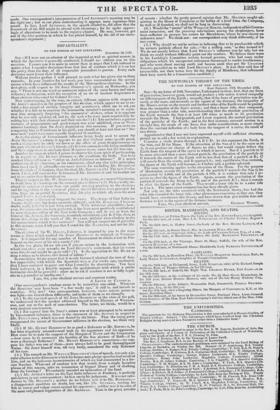THE NEWTONIAN THEORY OF THE TIDES.
TO THE EDITOR OF THE SPECTATOR.
East Dulwich, 20th December 1832.
SIR—In my letter of 19th November,II attempted to show, first, that any force.. of gravitation, however great, would not produce a tide unless it acted unequally on different parts of the Earth ; secondly, that if the force of gravitation was di- reedy as the mass, and inversely as the square of the distance,- the inequality of the Moon's action on the nearest and furthest sides of the Earth would be greater than the inequality of the Sun's action ; and that a lunar tide, thus compmed, was greater than a solar tide, notwithstanding that the absolute gravitation of the Earth towards thee e Sun is at, least 100 times as much as its gravitation towards the Moon. I had granted, and I even required, the mutual gravitation of the particles of the Earth; and in the first Instance, assumed motion in a straight line, the result of one force, that under consideration, as more simple than the constant deflection of a body from the tangent of a curve, the result of two forces.
Apprehensive that I may not have expressed myself with sufficient clearness, penult me to add a few words in explanation. Conceive a circle drawn through AB CD: let this represent the Earth, S
the Sun, and M the Moon. If the attraction of the Sun at C be the same as at A, it can produce no change of figure, no tide; but would simply deflect the Earth from the tangent of the curve in which it moves. But if a particlesat C be more attracted than a more distant particle, the gravitation of the particle at C towards the centre of the Earth will be less than that of a particle at II; C will recede from the centre, and B approach it ; and, equilibrium thus restored,
the figure of the Earth will become, as I before said, a prolate spheroid.. • The same reasoning applies to the attraction of the Moon. For the purpose
of illustration, assume the gravitation of the particle C towards the Sun to be represented by 1,000, and of the particle A 999, it is evident that Only 1 .0- mains to alter the figure of the Earth. Again, assume the gravitation of the particle D towayds the Moon to be 10, and of the particle B ; then 3 remain to alter the figure of the Earth. Thus would a lunar tide be to a solar tide as l; to-I. The more exact computation has been already given. Nut only are the tides consistent with the Newtonian theory, but had the solar tide exceeded the lunar tide, other phenomena remaining as they are, they would have overthrown this theory, and have shown that gravitation does not decrease so fast as the square of the distance increases. I am, Sir, your obedient servant, GEORGE WOODS.






















 Previous page
Previous page